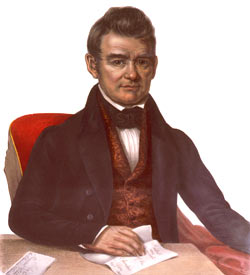|
 Resistance
to Removal
Resistance
to Removal
There
were small pockets of opposition to the removal of Cherokees
in Georgia and occasionally groups of people, such as the Quakers
and abolitionists, championed Indian rights. In
a petition to Congress in 1830, women from Steubenville, Ohio
used their only political right - the right of petition - to
protest
the
Cherokee
removal and to argue in favor of Native American natural rights.
Their petition was ignored.
Read
the petition
In
a farewell letter to the American people in 1832, George Harkins,
a Choctaw leader, denounces the evils of the removal policy.
Read
Harkins' letter.
 |
| John
Ross
McKenney
& Hall. "John Ross, a Cherokee chief / drawn, printed
& coloured at the Lithographic & Print Colouring
Establishment." Daniel Rice & James G. Clark, c
1843. Prints and Photographs Division, Library of Congress.
|
John
Ross, the principal Cherokee chief, was a leading opponent of
Indian removal.
Born
on October 3, 1790, Ross' Cherokee name was Tsan-Usdi, which means
Little John. He became Chief of the United Cherokee Nation.
Ross
made repeated trips to Washington as a representative of the Cherokee
people, and he even successfully argued the tribe's case before
the Supreme Court. The Supreme Court ruled in favor of the Cherokee
people, but President Andrew Jackson refused to send troops to
protect the American Indians on their homeland.
Read
Ross' speech.
In
1836, Chief John Ross submitted a memorial and protest to Congress,
declaring that the treaties that supposedly justified Cherokee
removal had been obtained by fraud.
Read
Ross' protest.
|
